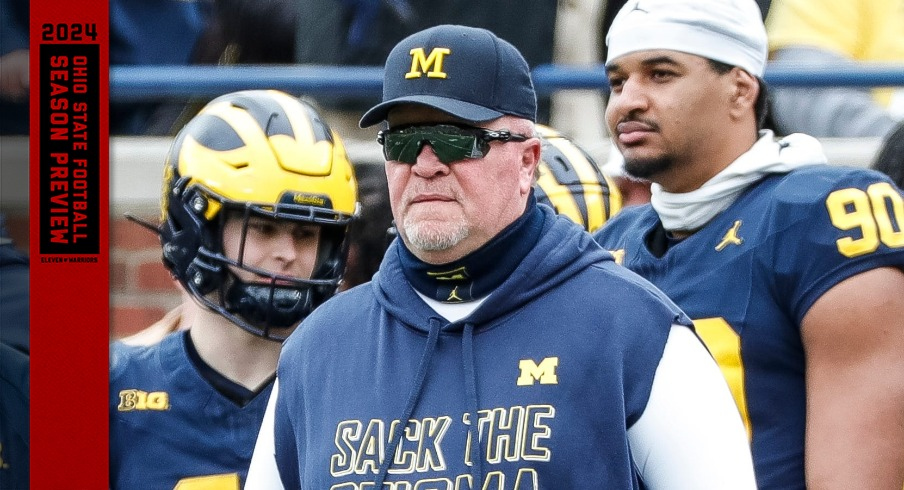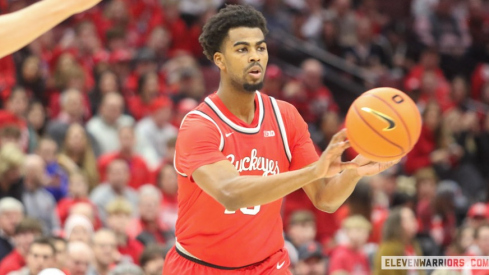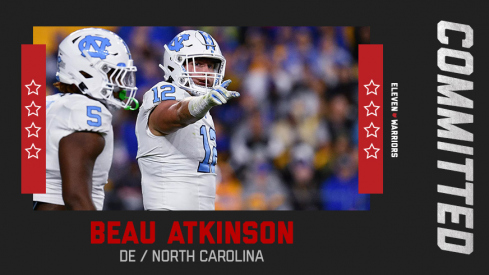Poor Don Brown.
When the veteran coach was given the reins of Michigan's defense in 2016, many of his contemporaries thought the old man would finally get his well-deserved time in the spotlight. While his unit would go on to rank in the top-10 nationally for four consecutive seasons, most fans across college football associate him with his few failures in the role.
Namely, the inability to slow down a young, up-and-coming former co-worker who, by then, was leading the offense of his biggest rival.
11W readers, both old and new, are surely familiar with the various manners in which Ryan Day shredded Brown's man-coverage schemes with crossing route after crossing route, making Parris Campbell a household name in the state of Ohio and continuing the Buckeyes' dominance over The Team Up North.
After an abysmal 2020 campaign in which nothing seemed to go right in Ann Arbor (both on and off the field, apparently), Brown was replaced by Mike MacDonald, then a relatively unknown linebackers coach in Baltimore. While MacDonald had previously been working for a coordinator in Don "Wink" Martindale known for playing schemes quite similar to Brown, relying heavily on blitzes and single-high coverage structures, the young coordinator rebuilt the Wolverine defense to look quite different during his lone season in Maize and Blue.
In 2021, as Ohio State lost to Michigan for the first time in a decade thanks in large part to its defensive shortcomings, Day's offense also failed to keep up, scoring a season-low 27 points. Though C.J. Stroud threw for 394 yards that snowy afternoon in Ann Arbor, the visitors struggled to move the ball on numerous occasions, plagued by a never-ending string of executional errors.
Much of the credit for these mistakes was given to the Michigan pass rush duo of Aiden Hutchinson and David Ojabo, who combined for four sacks while forcing numerous hurries and holding calls. But their performance largely overshadowed what MacDonald was doing in the secondary to reinvent the way Michigan defended Day's vaunted passing game.
No longer would the Wolverines rely on aggression to overwhelm the opposing offense. Instead, MacDonalds often disguised his coverage structure before the snap, showing one look...
...before dropping into an entirely different coverage structure after the play began.
Defenses have been disguising their coverages for decades, though rarely in this fashion. Nick Saban's defenses lined up with two deep safeties before 'rolling' to a single-high coverage (such as Cover 3) going back back as far as the mid 90s, influencing a young secondary coach named Mark Dantonio while the duo worked at Michigan State.
MacDonald was asking his secondary to do the opposite, however, showing the offense just one deep safety deep before a second defender bailed out to play a two-high look only once the ball had been snapped. Such an ask had long been thought too risky for defenses, leading to quarterbacks rarely ever seeing it.
This unique structure, which had been creeping into the NFL more and more by the time MacDonald took the job in Ann Arbor, kept the Buckeyes off balance. The additional time required to clearly identify the coverage held up the rhythm and timing of Stroud and his receivers, leading to enough off-target throws and missed opportunities that Jim Harbaugh was able to claim his first victory in the series.
MacDonald was given a promotion back at headquarters in Baltimore, taking over as Defensive Coordinator for the Ravens ahead of the 2022 season, where he found enough success to earn the head job in Seattle this past winter. His office in Ann Arbor was taken over by Jesse Minter, of course, who doubled down on the schemes his predecessor and former colleague with the Ravens had already set in place.
Like MacDonald, Minter mixed both three and four-man alignments along the defensive line while playing a variety of zone coverages behind them. But leading up to the 2022 game against Ohio State, Minter's defense had relied heavily on Cover 3 zones, for which Day, Stroud and co. had prepared.
Once the game began, however, they got many unexpected looks from their arch-rivals.
Minter relied far more heavily on simulated pressures, in which the defense crowds the line to show a blitz before the snap, only to drop seven defenders back in coverage as usual. The challenge for the offense is to identify which four players are still rushing the QB and how the back seven eventually drop back into pass coverage.
While the Buckeye O-line had its hands full sorting out the pass rush, Stroud once again was forced to identify coverages he not only didn't expect, but often didn't recognize. Minter's defense called for a heavy dose of Tampa 2 zone, but with a twist.
Rather than have the middle linebacker play the 'Vertical Seam' zone that sits in between the two deep defenders and turns the scheme into a hybrid between traditional Cover 2 and Cover 3, Minter rolled the coverage in a specified direction to have a safety employ that spot. Meanwhile, a cornerback dropped into a deep half (known as 'Inverted Cover 2').
The resulting picture for Stroud was once again made cloudy, as the defenders he'd been taught to key on were not dropping into alignments he recognized, forcing him to hold the ball and often check down to his running back.
To keep Stroud from catching on too quickly, though, Minter mixed in a healthy dose of Quarter-Quarter-Half coverage as well. With three defensive backs playing deep, it can look very similar to both Cover 3 or Tampa 2.
But while all three of those coverages look similar enough on the back end, each has very different weak spots which can be exploited by the offense. By mixing all three together and disguising them pre-snap, Minter bet that he could stay one step ahead of both the opposing play-caller and the talented QB to keep them from knowing when and where to attack.
Though Stroud still racked up another 349 yards through the air on Minter's defense that day, the Buckeyes once again fell short, leading many to wonder how the Wolverine DC had come away with another win, this time without the star edge rushers.
After getting shredded for over a half-decade, there were many opponents within the Big Ten willing to look anywhere for a way to slow down Ryan Day's offensive attack, leading many to attempt employing Minter's Inverted-Tampa 2 scheme.
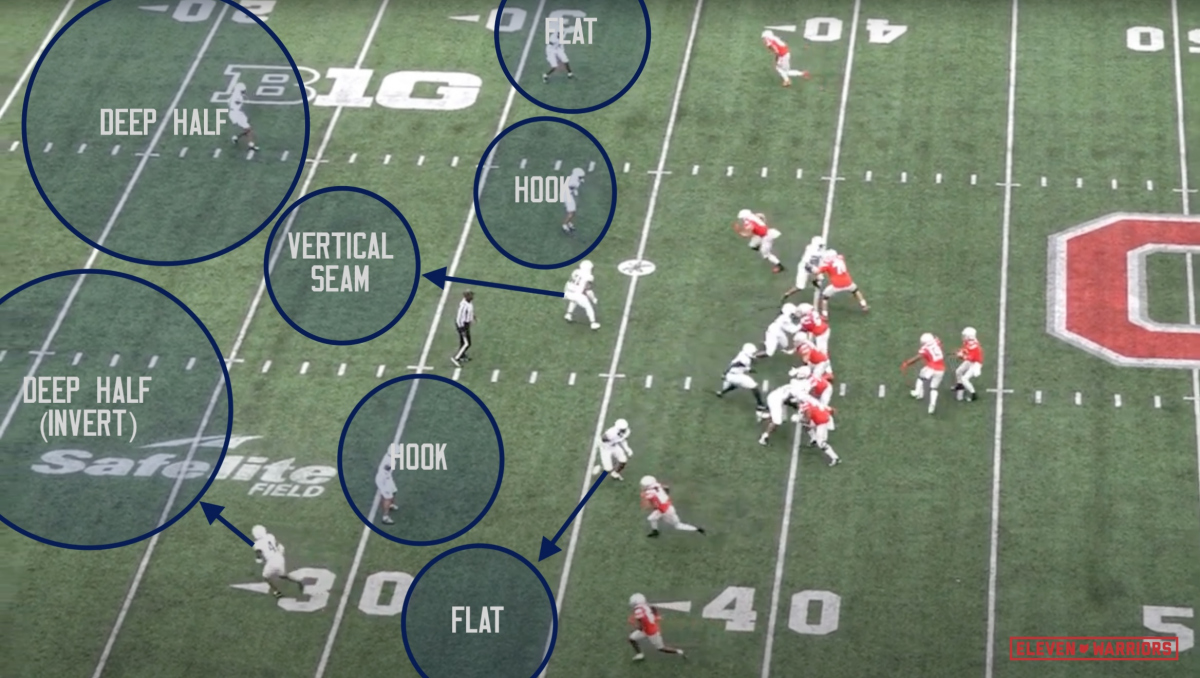
But even the most talented defenses in the league struggled to emulate the non-traditional coverage structures Minter employed, instead dumbing them down to more traditional versions that reminded many of why the Tampa 2 scheme fell out of favor 20 years ago. While the Chicago Bears might have reached a Super Bowl with the ultra-athletic Brian Urlacher running up the seam to cover lumbering tight ends in the 2000s, the spread offenses that redefined the sport in college and high school at the same time mercilessly attacked those players with faster receivers from the slot.
As tight ends, themselves, became more pass-catcher than additional tackle, they too proved capable of beating linebackers in pass coverage, as Cade Stover did against Penn State when the Nittany Lions tried to take a page from Minter's playbook.
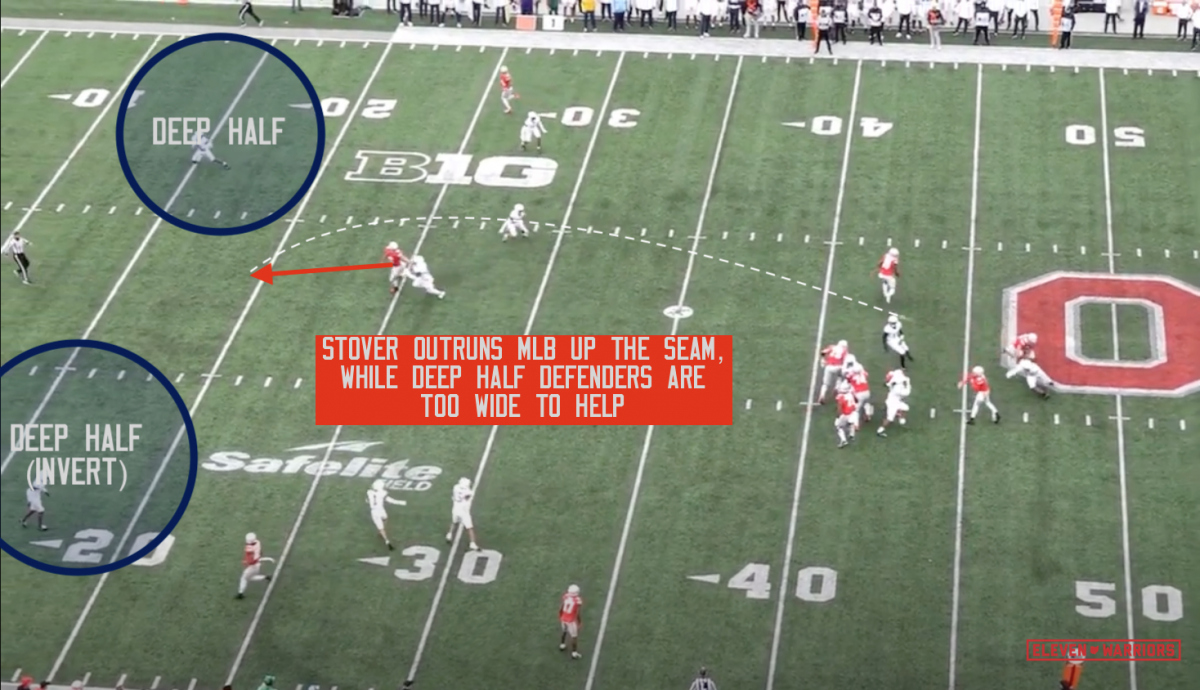
What many of those opponents failed to either understand or implement was the reason behind Minter's decision to use these Non-Traditional Tampa 2 coverages. Not only did he want to confuse the quarterback, he was clearly afraid of the guy wearing #18.
That Vertical Seam player, now a defensive back instead of a linebacker, would essentially follow the slot receiver based on his alignment, while two defenders always played over the top of Marvin Harrison Jr. outside. One would play a deep-half zone over the top while an underneath defender took away short slants, hitches, and crossing routes, creating a virtual bracket on the star receiver.
In both the 2022 matchup and during much of the 2023 game, Minter would play a more traditional Cover 2 look to the wide side of the field with a safety dropping into a deep half, while those roles flipped on the opposite side toward the boundary, with the cornerback playing an Inverted Cover 2 zone.
But early in the 2023 contest, Minter baited Kyle McCord into what may have been the game's most important mistake of the day by swapping these rules (without the assistance of Connor Stallions). Instead of dropping back into a deep half zone toward the boundary, cornerback Will Johnson instead stayed pressed up in the underneath flat toward Harrison, allowing him to intercept a slant route off an RPO and set up an early Michigan touchdown.
While the Wolverines used this Inverted Tampa-2 concept in both 2021 and 2022, they relied on it even more in last season's contest. Though they continued to play Cover 3 and Quarters at similar clips as they had against other opponents, Minter turned up the dial on Cover 2 variations, calling them nearly one-third of the time against OSU.
| Coverage | Season Average % | Against Ohio State |
|---|---|---|
| Cover 1 | 15.1% | 10.9% |
| Cover 2 | 10.5% | 32.7% |
| Cover 3 | 34.0% | 34.5% |
| Quarters (c4) | 18.2% | 18.2% |
| QQH (C6) | 13.3% | 5.4% |
McCord made a backbreaking mistake early against the coverage, but began to recognize it more as the game progressed and Minter continued to call it. As is the case with any zone coverage, there are weak spots that can be exploited, which in this case is behind the vertical seam dropper.
Whether by design or not, McCord was able to connect on a big gain early in the second quarter when motion from Emeka Egbuka exposed the post-snap rotation before the ball was in play. The QB had enough time on the play clock to change the play to a four-verticals concept that left Stover running vertically against an inside linebacker playing an underneath zone, allowing the athletic tight end to win a foot race to the coverage's weakest point.
As the game wore on, Day and his staff began countering the coverage, not only running the ball more against a lighter box, but by changing the alignment of their star wideout. Rather than leaving him out wide where Minter's coverage could bracket him with two players, they began lining Harrison up in the slot, where he'd have linebackers responsible for containing him instead.
By running layered crossing routes with Harrison as the most shallow receiver, it ensured he'd have a linebacker forced to chase him across the field, finding the end zone in the fourth quarter with this concept.
But the adjustments were too little, too late, as McCord accrued just 79 passing yards against Cover 2 variants on 14 attempts, an average of 5.64 per attempt to go with two interceptions. For context, McCord averaged 12 yards per attempt on other coverages that day, and threw just four interceptions in the prior 11 games last fall.
McCord, of course, now resides in Syracuse, while Minter followed his boss to back the NFL to deploy these tactics on the multitude of game-breaking receivers that populate the league, a cohort which now counts Harrison as a member.
In a move that surprised many, the regime in Ann Arbor hired Martindale, Minter's former mentor, to lead the Wolverine defense moving forward. The surprising part was not that new Michigan head coach Sherrone Moore looked to the same coaching tree that served his predecessor so well, but that Martindale has long employed a style far different to the one seen in Ann Arbor the past few seasons.
As the New York Giants' coordinator last season, his defense disguised its coverage just 17.6% of the time, the second-lowest mark in the NFL, while employing Cover 1 (man-coverage) a whopping 29% of the time (well above the league average of 19%). Minter's defense tended to drop back in zone coverage and only feign extra pressure, but Martindale's unit was one of the most blitz-heavy in the NFL. Meanwhile, he rarely employed Cover 2 schemes, calling them just 4.5% of the time, leading many to wonder just how much of Minter's system would actually remain.
If the spring game is any indication, however, it appears as though Martindale is trying to find a happy balance, sending more zone blitzes with two-deep zone coverages behind them, disguised with single-high safety looks pre-snap.
Michigan Spring Game Review:
— Cody Alexander (@The_Coach_A) July 3, 2024
Old School Is New Again
Wink Martindale brings his face-melter defense to Ann Arbor & the Big 10.
Pray for your alma mater's QB...
https://t.co/ouORVDsq2f#ArtofX pic.twitter.com/ZW746AOAHB
In addition to the Wolverines, however, Ryan Day, along with his new brain trust of Chip Kelly coordinating the offense and Will Howard lining up under center, will surely be tested with disguised Tampa 2 variations long before they take on Martindale on Thanksgiving weekend.
Oregon's Dan Lanning comes from the Nick Saban/Kirby Smart coaching tree, and while he has carved his own identity from a schematic perspective, he certainly has pages in his playbook that look similar to Minter's. Meanwhile, in State College, Tom Allen showed a great deal of disguise in his secondary while at Indiana, and will assuredly attempt to confuse Howard as the new defensive play-caller for Penn State.
Luckily, the Buckeye playbook already includes a number of pass concepts that attack the weakest spots in the zone.
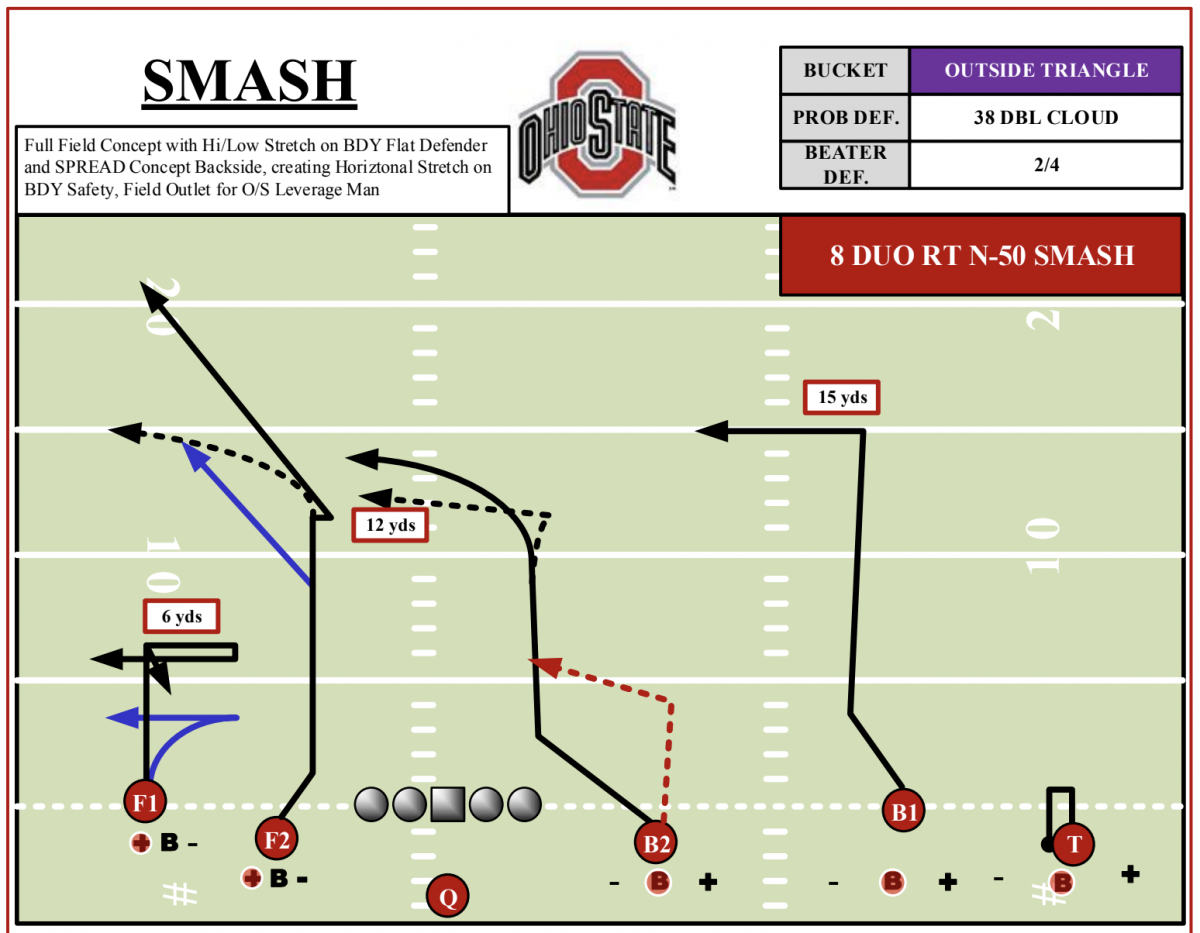
While middle school coaches know to employ the high-low Smash concept of an outside hitch under a corner route from the slot against Cover 2, Day turns the concept into a full-field read. As shown above, the QB would first look left to that high-low stretch before scanning the middle to find the deep over route, and finally getting to the deep dig route as his last read.
But the biggest weapon in staying ahead of any disguised defensive look is simply Kelly's presence inside the Woody Hayes Athletic Center during the week and on the sideline with Day on Saturdays.
While Day may have come up as a coach after the Tampa 2 system fell out of style, the former Oregon and UCLA head coach is a master of hiding his intentions through a variety of pre-snap alignments and motions, and will have the time and space to not only attack the tendencies of an opponent but to quickly adjust to what his offense sees without having to worry about managing the flow of a game.
Though Jesse Minter may have proven capable of matching wits with one of college football's best offensive minds, the balance of power on the coaching staffs in Columbus and Ann Arbor appeared to shift back south down Route 23 this offseason. Only time will tell if Martindale is capable of evolving as he approaches his fourth decade in the coaching ranks, or if he'll follow the footsteps of Brown, watching the sport zoom by, both literally and figuratively.
